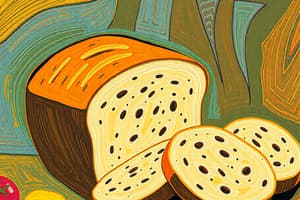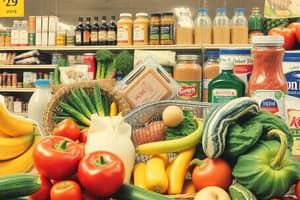Podcast
Questions and Answers
What is a staple food?
What is a staple food?
- A food that is regularly consumed in large quantities and provides a significant proportion of a person or group's dietary needs (correct)
- A food that is only consumed during special occasions
- A food that is not necessary for a person's diet
- A food that is consumed occasionally
What are some examples of staple foods?
What are some examples of staple foods?
- Processed foods
- Meat and dairy products
- Fruits and vegetables
- Cereals, starchy tubers or root vegetables, meat, fish, eggs, milk, cheese, and dried legumes (correct)
What factors contribute to the dominant staple foods in different parts of the world?
What factors contribute to the dominant staple foods in different parts of the world?
- Ecosystems (correct)
- Religious beliefs
- Acquired tastes
- Political systems
Which crops provide 2/3 of human food consumption?
Which crops provide 2/3 of human food consumption?
What percentage of the food eaten by half the population of sub-Saharan Africa comes from roots and tubers?
What percentage of the food eaten by half the population of sub-Saharan Africa comes from roots and tubers?
Why have many countries shifted away from low-nutrient-density staple foods?
Why have many countries shifted away from low-nutrient-density staple foods?
What is the negative impact of higher levels of carbon dioxide on some staple foods?
What is the negative impact of higher levels of carbon dioxide on some staple foods?
What is the nutrient-deficiency disease associated with a diet consisting primarily of maize?
What is the nutrient-deficiency disease associated with a diet consisting primarily of maize?
What is the nutrient-deficiency disease associated with a diet of refined white rice?
What is the nutrient-deficiency disease associated with a diet of refined white rice?
Flashcards
What is a staple food?
What is a staple food?
A food consumed regularly in large quantities and provides a significant portion of a person or group's dietary needs.
Give some examples of staple foods.
Give some examples of staple foods.
Cereals, starchy tubers or root vegetables, meat, fish, eggs, milk, cheese, and dried legumes.
What contributes to the dominant staple foods in different regions?
What contributes to the dominant staple foods in different regions?
The dominant staple foods are influenced by the local ecosystem.
What crops account for 2/3 of human food consumption?
What crops account for 2/3 of human food consumption?
Signup and view all the flashcards
How much food does the average sub-Saharan African get from root vegetables?
How much food does the average sub-Saharan African get from root vegetables?
Signup and view all the flashcards
Why have nations shifted away from less nutritious staple foods?
Why have nations shifted away from less nutritious staple foods?
Signup and view all the flashcards
What is the effect of higher carbon dioxide levels on staple foods?
What is the effect of higher carbon dioxide levels on staple foods?
Signup and view all the flashcards
What is Pellagra?
What is Pellagra?
Signup and view all the flashcards
What is Beriberi?
What is Beriberi?
Signup and view all the flashcards
Study Notes
Staple Foods: A Summary
- A staple food is a food that is regularly consumed in large quantities and provides a significant proportion of a person or group's dietary needs.
- Staple foods can be derived from vegetables or animal products, and typically include cereals, starchy tubers or root vegetables, meat, fish, eggs, milk, cheese, and dried legumes.
- The dominant staple foods in different parts of the world are a function of weather patterns, local terrain, farming constraints, acquired tastes, and ecosystems.
- 15 plant crops provide 90% of the world's food energy intake, with rice, maize, and wheat comprising 2/3 of human food consumption.
- Roots and tubers are important staples for over one billion people in the developing world, accounting for roughly 40% of the food eaten by half the population of sub-Saharan Africa.
- With economic development and free trade, many countries have shifted away from low-nutrient-density staple foods to higher-nutrient-density staples, as well as towards greater meat consumption.
- Most staple food is currently produced using modern, conventional farming practices, but the production of staple food using organic farming methods is growing.
- Consumed in isolation, staple foods do not provide the full range of essential nutrients.
- The nutrient-deficiency disease pellagra is associated with a diet consisting primarily of maize, while the disease beriberi is associated with a diet of refined white rice.
- The nutritional value of some staple foods is negatively affected by higher levels of carbon dioxide, as occurs in climate change.
- Potatoes, although a staple food, must be cooked, but should not be sprouted.
- The table in the text compares the nutrient content of 10 major staple vegetable foods in raw form on a dry weight basis to account for their different water contents.
Studying That Suits You
Use AI to generate personalized quizzes and flashcards to suit your learning preferences.




